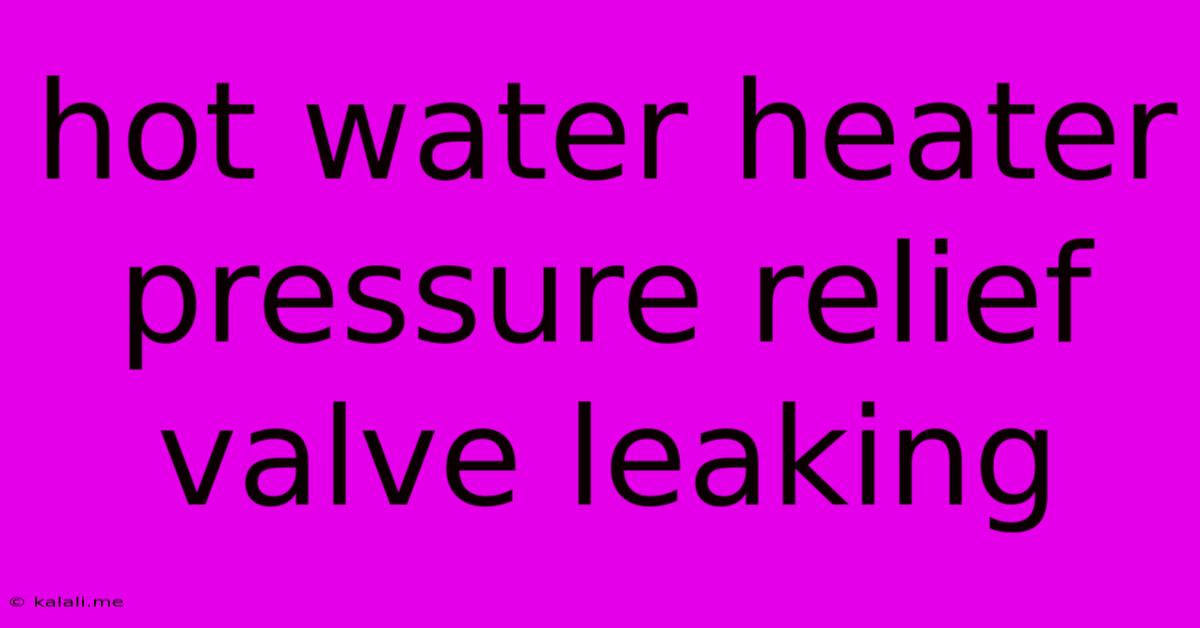Hot Water Heater Pressure Relief Valve Leaking
Kalali
May 26, 2025 · 4 min read

Table of Contents
Hot Water Heater Pressure Relief Valve Leaking: Causes, Fixes, and Prevention
A leaking hot water heater pressure relief valve is a serious issue that demands immediate attention. Ignoring it can lead to significant damage to your property and even pose a safety risk. This article will delve into the common causes of a leaking pressure relief valve, guide you through troubleshooting and repair, and offer preventative measures to avoid future problems.
What is a Pressure Relief Valve?
Before we dive into troubleshooting, let's understand the function of the pressure relief valve (PRV). This crucial safety device is designed to release excess pressure within your hot water heater. Excessive pressure can build up due to various factors, including overheating, sediment buildup, or a malfunctioning temperature and pressure relief valve (T&P valve). The PRV acts as a failsafe, preventing potentially dangerous explosions. A small drip from the PRV is sometimes normal, but a steady stream or significant leak indicates a problem.
Causes of a Leaking Hot Water Heater Pressure Relief Valve
Several factors can contribute to a leaking hot water heater pressure relief valve:
1. Excess Pressure:
- Overheating: A faulty thermostat or heating element can cause the water to overheat, resulting in increased pressure.
- Sediment Buildup: Mineral deposits accumulate at the bottom of the tank over time, reducing its effective volume and increasing pressure when heated.
- Closed Pressure Relief Valve: Though rare, a completely blocked valve can also contribute to a leak after pressure has built up and then been released.
2. Valve Malfunction:
- Worn-out Valve: Over time, the valve's internal components can wear out, leading to leakage. This is a common cause and often requires valve replacement.
- Corrosion: Exposure to water and minerals can cause corrosion of the valve components, compromising its seal and causing leaks.
3. External Factors:
- Temperature Fluctuations: Extreme temperature changes can impact the valve's performance and lead to leaks.
- Water Hammer: Sudden surges in water pressure (water hammer) can stress the valve and eventually cause it to leak.
Troubleshooting and Repairing a Leaking Pressure Relief Valve
While minor adjustments might temporarily alleviate the issue, a consistently leaking valve generally requires replacement. Before you attempt any repairs, always turn off the power to the water heater and allow it to cool down completely.
Step 1: Check for Excess Pressure
Carefully check the pressure gauge on your water heater. If the pressure is excessively high (above the recommended range), you need to address the root cause of the high pressure before replacing the valve. This might involve flushing the tank to remove sediment.
Step 2: Inspect the Valve
Examine the valve for any visible signs of damage, corrosion, or mineral deposits. If you see significant corrosion or damage, replacement is almost certainly necessary.
Step 3: Replacing the Pressure Relief Valve (If Necessary)
Replacing the pressure relief valve is a relatively straightforward task, but it's crucial to follow safety precautions and handle the water heater carefully. If unsure, contact a qualified plumber. This step usually involves:
- Turning off the water supply.
- Relieving any remaining pressure.
- Disconnecting the old valve.
- Installing the new valve.
- Reconnecting the water supply.
- Testing for leaks.
Prevention is Key:
Regular maintenance can significantly extend the lifespan of your hot water heater and prevent pressure relief valve issues:
- Flush the tank annually: Removing sediment buildup reduces pressure and extends the life of your water heater.
- Inspect the valve regularly: Checking for leaks and signs of corrosion allows for early detection of problems.
- Maintain proper water pressure: High water pressure puts extra strain on the system and the PRV, so maintain pressure within the recommended range.
- Consider a water softener: A water softener helps to reduce mineral buildup and prolong the life of your water heater and other appliances.
A leaking hot water heater pressure relief valve is a serious issue that needs prompt attention. While some minor adjustments may temporarily fix a minor leak, a consistently leaking valve signals a more significant problem and usually necessitates replacement. By understanding the causes, troubleshooting effectively, and practicing preventative maintenance, you can ensure your hot water heater operates safely and efficiently for years to come. Remember, safety should always be your top priority. If you are uncomfortable performing these repairs yourself, it is always best to contact a qualified plumber.
Latest Posts
Latest Posts
-
How To Remove Tea Stains From Cups
May 27, 2025
-
On The Meeting Or At The Meeting
May 27, 2025
-
No Cuts No Buts No Coconuts
May 27, 2025
-
Conversion Failed When Converting From A Character String To Uniqueidentifier
May 27, 2025
-
Work With The Left Hand Side Get A Common Denominator
May 27, 2025
Related Post
Thank you for visiting our website which covers about Hot Water Heater Pressure Relief Valve Leaking . We hope the information provided has been useful to you. Feel free to contact us if you have any questions or need further assistance. See you next time and don't miss to bookmark.